Nino Rota’s one-act radio opera, Il due timidi, was composed for Radio Audizioni Italiane and first broadcast in November 1950. Its first London performance took place at the Scala Theatre (London Opera Club) in March 1952. Presumably this was the prompt for director Rodula Gaitanou to set all three of the little-known one-acters forming the Guildhall School of Music and Drama’s autumn triple bill in La Scala Picturehouse, sometime during the late 1920s.
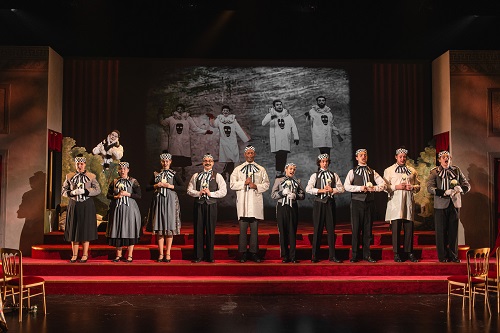
Designers Simon Corder (sets and lighting) and Laura Jane Stanfield (costumes and props) take us on a tour of the gracious old cinema. So, Des Grieux’s haunting sorrow and subsequent epiphany in Massenet’s Le portrait de Manon unfold in the cinema’s projection room, where the middle-aged projectionist trawls through the photograph collection by which he clings to his memories of tragic love and loss. Then, in Ethel Smyth’s Fête Galante we see the Picturehouse employees put on a welcome entertainment in the auditorium for the new owners of the cinema. Finally, and some years later, we return to the box office of La Scala, now fallen into disrepair under Signora Guidotti’s ownership, to witness the thwarted romance of the two ‘timidi’, Raimondo and Mariuccia, who in Rota’s sentimental romance fail to find the words to speak of their love and secure their happiness.
The operas’ protagonists become box office staff, ushers, managers, projectionists, cinemagoers; the boundaries between life and theatre are blurred, sometimes broken. As Gaitanou explains, ‘This microcosm hosts their everyday life, tainted by their dreams and aspirations, their pain and torment, and their attempt to make life move forward.’ To be honest, it feels a rather contrived attempt to unite three disparate operas, which Gaitanou suggests share themes of tormented love and identity. There are further attempts to visually cohere the trio into a triptych. Thus, the film projected during Le portrait, Artur Robinson’s 1926 silent feature Manon Lexcaut, starred the Hungarian actress Lya de Putti in the title role, and it is her image that Des Grieux obsessively re-visits. The acrobat costume that De Putti wore in Varieté, a 1925 silent film by Ewald Andre Dupont, inspires the Puppet Quartet’s skull-embossed costumes in Fête Galante. And, the La Scala projection room and box office both allude to Buster Keaton’s Sherlock Jr. The links don’t really serve much purpose but neither do they do any harm, and they do impose a visual unity of a sort.
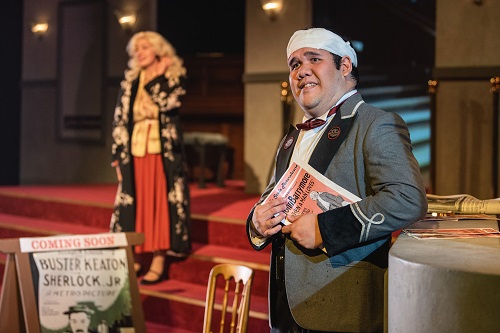
Of the three operas, I due timidi has the slightest plot but, I felt, the most engaging music. In fact, it has a sort of ‘non-plot’, though one that makes for a lively ensemble piece. The libretto, by Rota’s long-term friend and collaborator, the film writer Suso Cecchi D’Amico, seems to ironically engage with the radio format which means that the listener doesn’t ‘see’ the action. So, the shy would-be beloveds’ vision becomes confused, leading to various miscommunications, and ultimately to the failure of communication as they demur and are deflected from revealing their love. The original action takes place in a hotel. Raimondo arrives, ostensibly seeking the owner Signora Guidotti, but really because he loves Mariuccia. An unfortunate accident – a window shutter falls on his head (here, the box office explodes) – knocks him out and in his post-mishap delirium he confesses his love, not to Doctor Sinisgillo who has been called to treat him, but to the stunned but delighted Signora. The Doctor is called away to treat Mariuccia whose confession of love for Raimondo leads the opportunistic medic to propose. The timid youngsters are horrified but too shy to reveal their mistakes and so forsake their love.
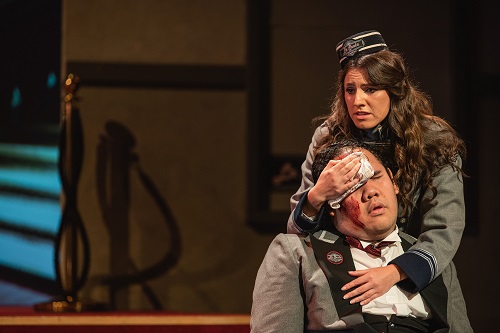
Rota (1911–79) was the composer of over 150 film scores, many very well-known (The Godfather, Romeo and Juliet, La strada, La dolce vita),but though he also wrote a dozen operas and orchestral, instrumental and chamber works, his ‘serious’ music has failed to enter the repertoire. Perhaps this is because of the conservative nature of his musical language, but his style is lyrical and absorbs diverse influences – Puccini, Italian popular song, jazz – and is eminently ‘listenable’.
At the Guildhall, the young singers captured the liveliness and tunefulness of the score, coped well with Rota’s sometimes demanding vocal lines, and engaged with both the comic capers and the contrasting moments of sentiment and sadness. As Raimondo, Mark Bautista displayed an appealing tenor and a nice line in bittersweet resignation, and soprano Faryl Smith’s tender singing won sympathy for the hopeful but hapless Mariuccia. Dr Sinisgillo’s machinations were neatly delivered by tenor Jack Dolan, Alexandra Meier was persuasive as Mariuccia’s social-aspiring mother, while as Signora Guidotti Alexandra Achillea Pouta revealed a terrifically vibrant mezzo soprano, powerfully capturing the Signora’s feverish joy at the chance to relive her youthful passion. The rest of the cast worked hard and did well to make something out of what is really not very much, and which at times doesn’t seem to know whether it wants to be merry farce or tragic misfortune.
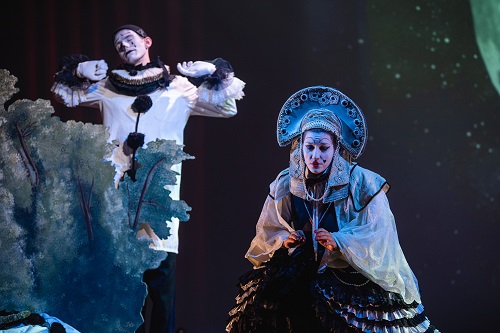
If the action of Rota’s opera is slight, Ethel Smyth’s Fête Galante (1923) has a libretto – fashioned by the composer and Edward Shanks – of complexly entangled romance, rivalry and rejection. Essentially, everyone wants Columbine: after a play in which Harlequin steals her from Pierrot, the King and Queen meet the players and the monarch himself tries his luck, fruitlessly, with the lively young servant. Meanwhile, play and life intertwine: Pierrot is convinced he has lost his beloved, she becomes frustrated when he ignores her reassurances and departs with Harlequin, only later to return and, espying an assignation between the Queen and her Lover, mistakes Pierrot for the latter. She marches off to tell the King what she’s witnessed, and when Pierrot refuses to respond to the King’s interrogation, he is sentenced to death.
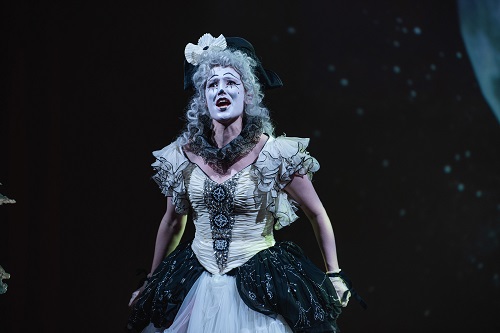
Gaitanou further complicates matters by introducing copious stage business involving an inanimate mannequin. But, the design is beguiling, blending commedia, fairy-tale and pantomime, and Stanfield’s costumes are detailed, combining elegance and imagination. There’s plenty of room in the score for waltzes, musettes and madrigals (the latter pleasingly sung by the Chorus), and the stage movement and dance is deftly done, the symbolism of the Puppet Play effectively conveyed. Atmospheric video projections enhance the sense of the magical, the pale indigo sky and purple-tinged moon evoking the nocturnal Watteau-garden of the original setting. As Smyth’s music switched between taut, angular rhythms, more conventional lyricism, and occasional Wagnerian gestures, the emotions conveyed by the singers were always very real and affecting, and the words were clearly heard too (though Shanks’ clichés were not always worth hearing).
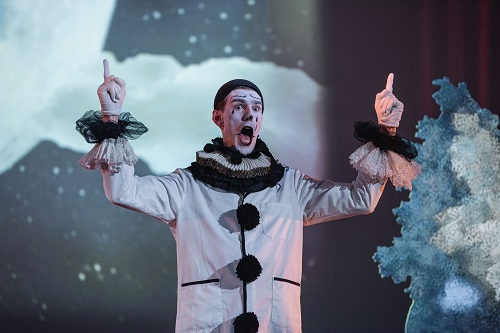
As Columbine, soprano Louise Stirland displayed the requisite lightness of voice and strong dramatic presence; her quarrel with Pierrot was eloquent and compelling. Baritone Jonathan Eyers has impressed frequently of late, both at the GSDM and during Bampton Classical Opera production this summer of Fool Moon (Haydn’s Il mondo della luna) – the latter a show-stealing performance as the pompous, gullible Bonafede. Here, Eyers swapped comic irony for tragic heroism, imbuing the lonely, isolated Pierrot with dignity and singing with beautiful lyrical direction and depth of expression, especially in the central aria in which Pierrot sings of the joys of solitude. There were strongly characterised performances from Alexandra Achillea Pouta as the faithless Queen and baritone Michael Lafferty-Smith as the imperious King, with Jack Dolan (The Lover) and Mark Bautista (Harlequin) again singing with accomplishment.
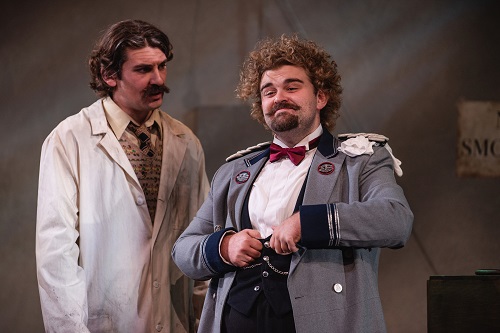
The evening opened with Massenet’s Le portrait de Manon (1894), a sequel to Manon (1884) in which the aging Des Grieux, lost in his memories, forbids a relationship between his young protégé, Jean, and the sixteen-year-old Aurore. The urgings of his old friend, Tiberge, are initially futile, but eventually Des Grieux comes to terms with his past in order that the future might flourish.
Corder’s grey palette conveyed the sorrow which has chilled Des Grieux’s heart and cocooned him from the world (in the original the old chevalier is living alone in Provence where he keeps a miniature of Manon in a tiny box), though colour and light were introduced through the singing of soprano Inguna Morozova as Aurore and mezzo-soprano Nancy Holt as Jean. Dolan was a confident Tiberge, projecting well, and baritone Patrick Dow convincingly conveyed Des Grieux’s transition from restraint to remorse and renewal. Massenet’s music is, as always, elegantly crafted – he makes extensive use of themes from his earlier Manon – and the cast of four served it well.
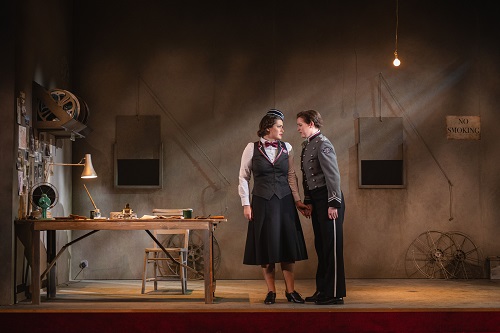
Conductor Dominic Wheeler paced and controlled the dramatic direction with customary effectiveness from the pit, and drew fine playing from the GSMD Orchestra: textures were sharply defined, the tone warm, lyricism and liveliness were well balanced, and the intonation was very good. Clearly much hard work had gone into these performances, both on and from behind the stage. But, while the performances were impressive and the music did charm at times, I’m not sure that this trio of operas will make much of a mark on my musical memory.
Claire Seymour
Jules Massenet: Le portrait de Manon
Des Grieux – Patrick Dow, Tiberge – Jack Dolan, Jean – Nancy Holt, Aurore – Inguna Morozova
Ethel Smyth: Fête Galante
The King – Michael Lafferty-Smith, The Queen – Alexandra Achillea Pouta, Harlequin – Mark Bautista, Pierrot – Jonathan Eyers, Colombine – Louisa Stirland, The Lover – Jack Dolan, Puppet Quartet – Inguna Morozova, Alexandra Meier, Mark Bautista, Joe Chalmers
Nino Rota: I due timidi
Mariuccia – Faryl Smith, Raimondo – Mark Bautista, Dr Sinisgillo – Jack Dolan, Lucia – Louisa Stirland, Maria – Inguna Morozova, Lisa – Nancy Holt, Signora Guidotti – Alexandra Achillea Pouta, Le madre di Mariuccia – Alexandra Meier, Il narratore – Joseph Chalmers, Vittorio – Jonathan Eyers, Il pensioniere – Patrick Dow/Michael Laffery-Smith
Director – Rodula Gaitanou, Conductor – Dominic Wheeler, Set and Lighting Design – Simon Corder, Costume Design and Props – Laura Jane Stanfield, Movement Director – Victoria Newlyn
Silk Street Theatre, Guildhall School of Music and Drama, London; Monday 7th November 2022.
ABOVE: Joseph Chalmers (as Il narratore in I due timidi) © David Monteith-Hodge (Photographise)